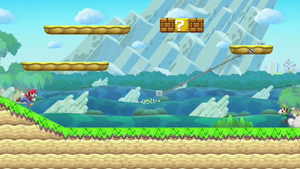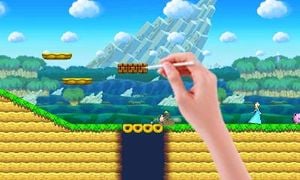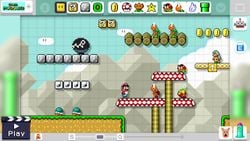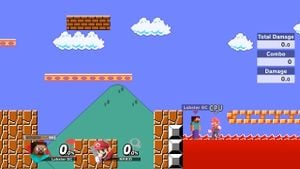Super Mario Maker
| Super Mario Maker Super Mario Maker | |
|---|---|
 Super Mario Maker in its New Super Mario Bros. U form. | |
| Universe | Mario |
| Appears in | SSB4 Ultimate |
| Availability | Downloadable (SSB4) Starter (Ultimate) |
| Crate type | Normal |
| Maximum players | 4 (3DS) 8 (Wii U and Ultimate) |
| Article on Super Mario Wiki | Super Mario Maker |
Super Mario Maker (スーパーマリオメーカー, Super Mario Maker) is a downloadable stage that appears in both versions of Super Smash Bros. 4. It was officially revealed on September 14th, 2015, and was released on September 30th, 2015.[1] The stage also appears in the base game of Super Smash Bros. Ultimate.
Stage overview[edit]
The stage is based on the game of the same name. At the start of a match, a randomly chosen cursor from Super Mario Maker customizes the stage's layout. Fighters start on pink temporary platforms that vanish when jumped off of, rolled on, or walked off of. During the match, the cursor will repair any blocks that break on the stage.
This stage initially appears in one of four different game styles: Super Mario Bros., Super Mario Bros. 3, Super Mario World, or New Super Mario Bros. U. Occasionally, the styles will switch at random mid-match. In Super Smash Bros. for 3DS, the standard version of the stage alternates between two of the four themes, but in Super Smash Bros. for Wii U and Ultimate, it cycles through all four themes.
The randomly-generated stage may be a floating island or a walk-off stage with bottomless pits, and may feature slopes. Elements that can appear on the stage include:
- Stationary floating soft platforms (can be tilted)
- Platforms that move along rails
- Mushroom platforms
- Bridges protruding from walls
- Donut Blocks that fall when stood on
- Breakable Brick Blocks (in the Super Mario World style they become Rotating Blocks, which spin when hit and become intangible until stopped by the cursor)
- Unbreakable blocks
- ? Blocks that yield items when hit (often items from Mario games; the cursor will refill these blocks periodically)
- Warp Pipes
- Slippery Ice Blocks
- Conveyor belts
- Lava pools
In Super Smash Bros. for Wii U and Ultimate, various Mario objects and enemies sometimes fly by in the background, including three Bullet Bills, a Hammer Bro, a Koopa Troopa, and a Lakitu flying by in Lakitu Clouds, and a Goomba (replaced with a Galoomba when in the Super Mario World style) riding a Koopa Clown Car.
Ω forms and Battlefield form[edit]
In Super Smash Bros. 4, the Ω form of the stage features a single platform whose bottom extends downward slightly using inverse slopes. Thus, the layout of this form of the stage will always be the same, but it still cycles between four themes (even in the 3DS version), making this one of two Ω form stages that can appear differently.
In Super Smash Bros. Ultimate, the Ω form and Battlefield form function identically to how the Ω form does in SSB4; however, the stages are slightly resized and reshaped to match Final Destination and Battlefield, respectively. The three soft platforms of the Battlefield form are based on the floating platforms found in the normal version of the stage. The characters are still flat, which also flattens the hitboxes and alters gameplay significantly as a result.
Hazards Off[edit]
With hazards off in Ultimate, the stage is still completely randomly generated, can potentially feature slopes, and can be a floating island or have walkoffs. The stage can still change between the four different styles. The following stage elements can be used when the level is created:
- Floating soft platforms (can be tilted)
- Mushroom platforms
- Bridges
- Warp Pipes
The following stage elements will not be used when the level is created:
- Rail-guided platforms
- Donut Blocks
- Breakable Brick Blocks / Rotating Blocks
- Unbreakable blocks
- ? Blocks
- Ice Blocks
- Conveyor belts
- Lava pools
Origin[edit]
The foundation for the original title was conceived as a spiritual successor to Mario Paint, as Nintendo was interested in creating a successor for the Wii U utilizing the GamePad's potential as a drawing tool. Meanwhile, the in-house development tools that would usually be used to create 2D Mario levels were seen as enjoyable enough by staff to be pitched to Nintendo as a standalone project. Nintendo veteran Takashi Tezuka decided to combine the two concepts into one, and the result was Super Mario Maker, officially revealed at E3 2014 and releasing in September 2015 in commemoration of the series's 30th anniversary. This was also the first game to feature Mario in his Builder outfit.
In the original Wii U game, players can create their own 2D Mario levels to play and share online using the four themes found on this stage. While editing a level by using the Wii U GamePad's touchscreen, a cursor appears on the TV screen as either a hand holding a stylus, a cat's arm, Mario's arm, or the hand cursor from Mario Paint. If a player tests their level with Mario placed above a bottomless pit, he will spawn on a small pink platform. Each theme includes Mario’s moveset from that respective title, such as the spin jump, kicking objects vertically, and the wall jump. The four game styles come with a multitude of themes such as Ground, Underwater, Underground, Airship, and Ghost House. Assets from across the four game styles can be placed including the game-exclusive power-ups such as the Super Leaf and Propeller Mushroom.
Most of the playable characters of Smash 4 (the exceptions being Mii Fighters, and all DLC characters aside from Mewtwo and Lucas) are available in Super Mario Maker as costumes for Costume Mario, unlocked via amiibo or by playing through the 100 Mario Challenge, which tasks the player to beat a certain number of levels starting out with 100 lives. These costumes are accessed via the Mystery Mushroom, only available in the original Super Mario Bros. game style. Subsequent patch updates would add new assets and features such as Event courses with more Mystery Mushroom costumes, checkpoint flags, keys, and a new difficulty option for the 100 Mario Challenge, Super Expert mode. While their appearances are unconnected to Smash, several characters throughout the series are also costumes for Costume Mario; this includes Squirtle and the Ice Climbers, two characters cut in the transition from Brawl to SSB4, Princess Daisy, the Inklings and Isabelle, who would later be joined as playable characters in Ultimate, several Assist Trophies (Arcade Bunny, Ashley, Barbara, Dr. Kawashima, Kapp'n, Midna, Mr. Resetti, Nikki, Squid Sisters, Starfy, Tingle and Waluigi), Birdo, Charmander, Mr. Saturn, Slippy Toad, Peppy Hare, and Nabbit.
An adapted port for the Nintendo 3DS, Super Mario Maker for Nintendo 3DS, was announced a year after Super Mario Maker's initial launch and released in December 2016. It contains most of the features of the original game (including an expanded single player campaign) and separates certain assets such as arrow signs and checkpoint flags, while omitting certain features such as the Mystery Mushroom costumes and amiibo support, and limiting course sharing to local wireless instead of over Nintendo Network.
An expanded sequel for the Nintendo Switch, aptly titled Super Mario Maker 2, was released in June 2019. This sequel adds many new features that were not seen in either the Wii U or 3DS entries, some of which were included in the Super Smash Bros. stage of the same name. This includes slopes, tilting platforms, adjustable water levels, snake blocks, custom scrolling, new enemies such as the Angry Sun and Boom Boom, and additional level themes. There is also a new game style, Super Mario 3D World, which has many features exclusive to its courses, such as the Super Bell power-up, clear pipes, and new enemies such as Piranha Creepers and Koopa Troopa Cars. The new Story Mode expands even further on the single player content present in previous installments. Courses can now also be cleared with specific prerequisites such as collecting a certain number of coins or defeating a certain number of enemies. Online multiplayer options were expanded to include tags for searching levels and simultaneous competitive and cooperative online multiplayer for up to four players. Subsequent patches expanded and added features for creating and playing levels, including new and returning power-ups like the Master Sword, level assets, enemy types, the ability to play online multiplayer with people on the player's friends list, and an overworld to chain multiple levels in the style of traditional Super Mario game.
Tournament legality[edit]
Super Mario Maker's unpredictable and uncontrollable stage layout that is different for every match has led it to be universally banned from tournaments, as it can potentially possess numerous elements deemed unacceptable for competition, including a cramped scale, caves of life, camping spots, or stage hazards such as lava, disrupting the fight. Also, the hand that repairs the blocks can come in at the wrong time and stop recoveries. The Battlefield and Ω forms are also banned due to the character's flat hitboxes.
Update history[edit]
Introduced a bug where lava floors will sometimes not damage or launch fighters.
Introduced a bug where Ice floors will sometimes not reduce the traction of applicable fighters.
 Fixed the lava floor bug, as the terrain will now properly damage and launch fighters.
Fixed the lava floor bug, as the terrain will now properly damage and launch fighters.
Reveal trailer[edit]
Gallery[edit]
Super Smash Bros. for Wii U[edit]
Super Smash Bros. for Nintendo 3DS[edit]
Super Smash Bros. Ultimate[edit]
Pac-Man using Power Pellet on Wii Fit Trainer on the stage.
Mario with a Super Leaf floating over Piranha Plant's blue, gray, pink, and green costumes on the stage.
Names in other languages[edit]
Trivia[edit]
- In Ultimate, the lava on Super Mario Maker can temporarily cause a fighter's damage to exceed the 999% damage cap. The damage meter will still read 999.0%, but when damaged the opponent behaves as though their damage were higher than this limit. The effect wears off after the fighter's damage is updated by something other than the lava on the stage. This anomaly also occurs on Stage Builder, but does not appear to occur on Norfair.
- In Japan, Super Mario Maker is the most recent game represented in Super Smash Bros. 4, released about three weeks before the stage released, but in Europe and North America, it is beaten by Fire Emblem Fates.
- Certain structures in this stage such as slopes, tilted platforms, and pools of lava cannot be replicated in the Super Mario Maker game. Lava only appears at the bottom of stages using the Castle theme, and slopes cannot be placed at all.
- Slopes and tilted platforms eventually found their way into Super Mario Maker 2.
- This is the only stage in Ultimate wherein it is not possible to rotate the camera at all when using camera controls. Additionally, despite the "angled" camera setting in Special Smash usually being able to bypass camera restrictions on stages, the camera will still be prevented from angling at all when the setting is enabled.
- One of the possible random layouts for this stage is a single platform akin to its Ω form, but thinner. [2]
- Super Mario Maker is the first Super Smash Bros. stage with any part of its design based on Super Mario Bros. 3.
- Super Mario Maker is one of three stages in SSB4 to share music with other stages, the others being Pirate Ship and Big Battlefield. Castle Siege and Coliseum also share two tracks if Corrin is downloaded.
- Prior to Super Smash Bros. Ultimate, Super Mario Maker had the largest music selection of any Super Smash Bros. stage, at 27 tracks. In Super Smash Bros. for Nintendo 3DS, it is one of two stages to have more than two music tracks, having five possible tracks. Dream Land has six possible musical selections.
- In addition, while every stage from the same series shares the same tracklist (pertaining to songs from the series they belong to) in Ultimate, Super Mario Maker is the only one to have an exclusive track.
- Super Mario Maker and Duck Hunt are the only stages where Star KOs only occur in Super Smash Bros. for 3DS.
- However, it does not feature Screen KOs, similar to another stage in the Wii U version.
- Super Mario Maker is the only paid downloadable stage that is neither a past stage nor bundled with a fighter.
- Despite being from the Mario universe, it is also the only DLC stage in the 3DS version and the only paid DLC stage in the Wii U version to not appear in All-Star Mode.
- This is the only stage in the series to have an official reveal trailer.
- This is the only stage in the 3DS version with a slippery surface (although it doesn't always have one), including Smash Run.
- In Ultimate, the following Assist Trophies cannot appear on this stage: Skull Kid, Nightmare, Andross, Ashley, Devil, Dr. Wright, Nintendog, Nikki and the Squid Sisters. Additionally, the following Poké Ball Pokémon cannot be summoned: Snorlax, Lugia, Arceus, Xerneas and Lunala.
- Oddly, in the reveal trailer for the stage, King Dedede's name is displayed as "Dedede", his Japanese name, despite Charizard's name being translated from "Lizardon".
References[edit]




















